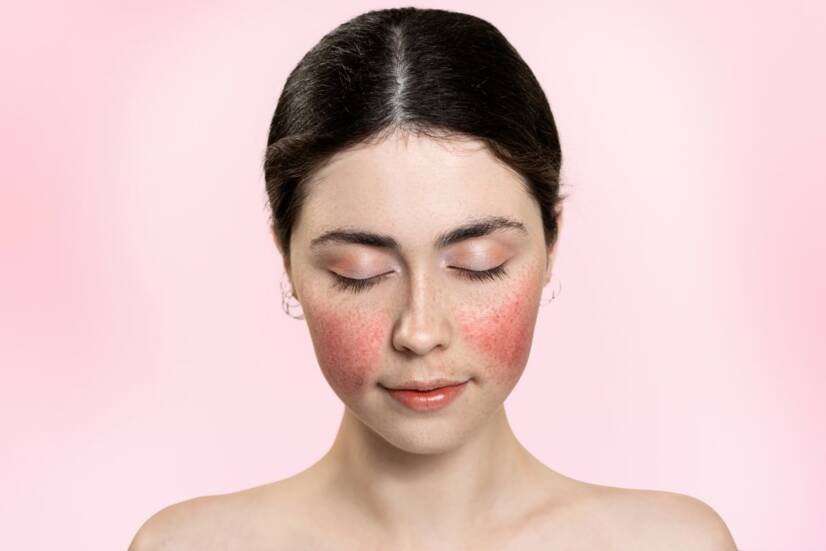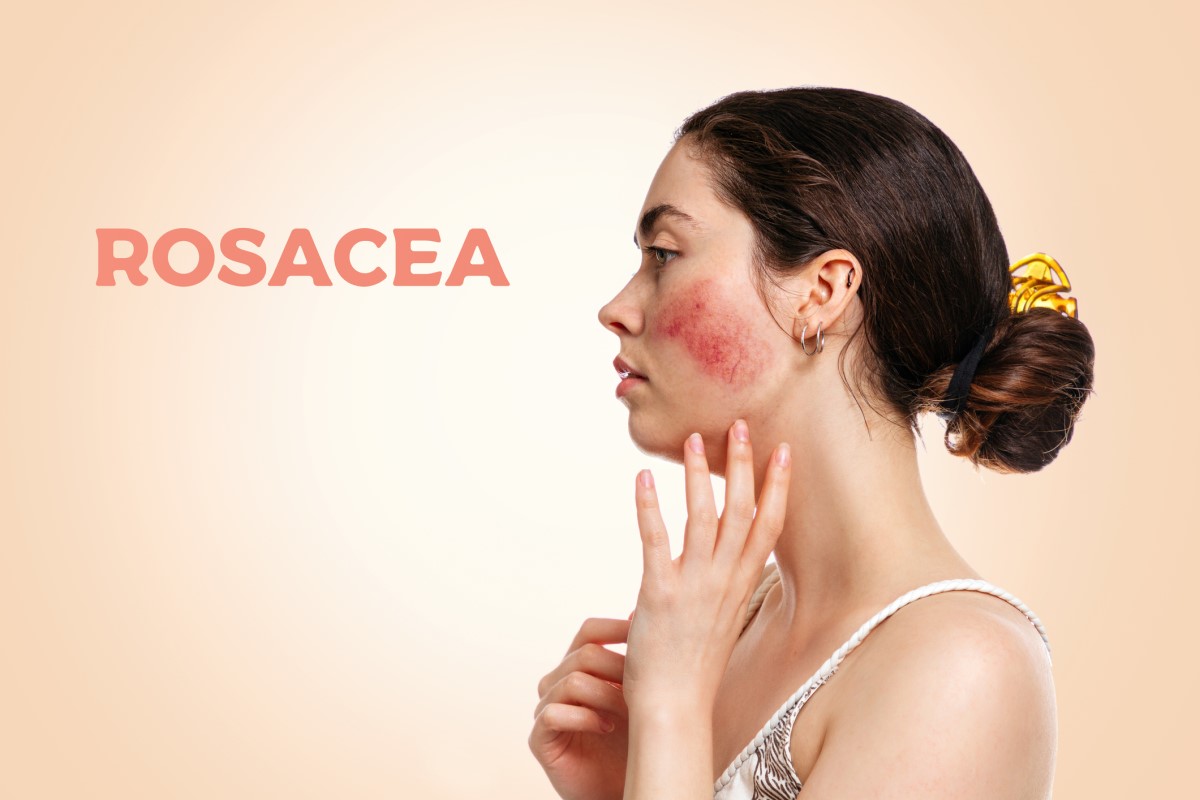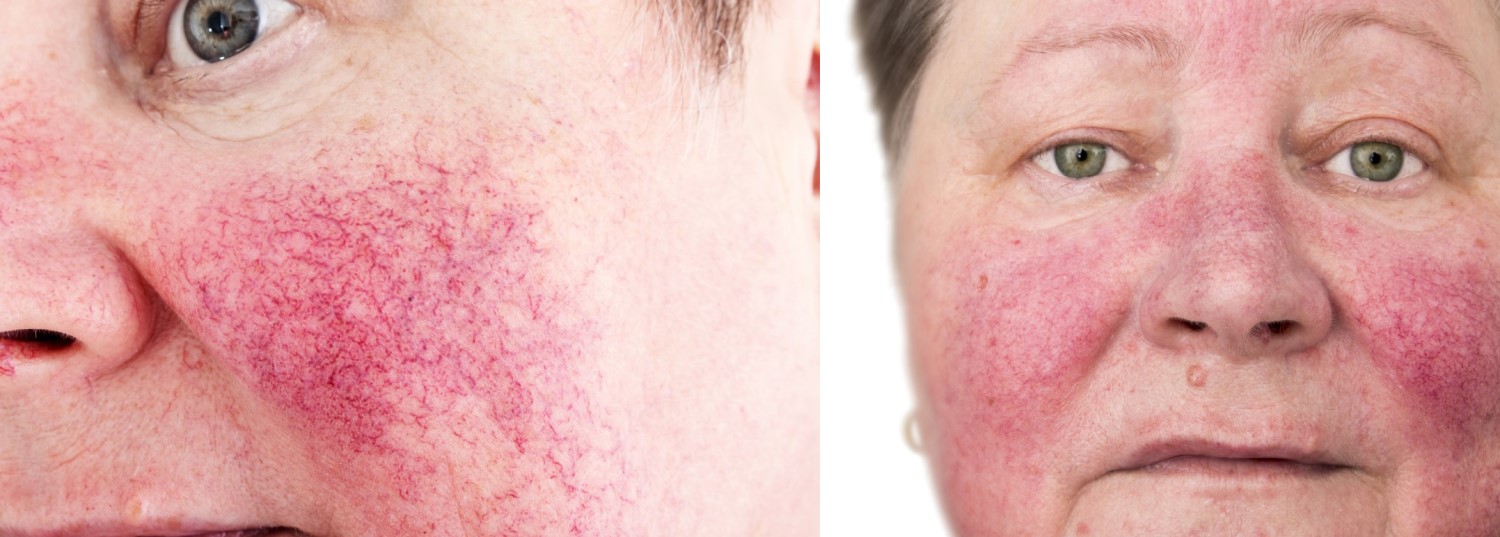- solen.sk - Therapeutic possibilities of rosacea, MUDr. Andrea Kozárová, PhD., MUDr. Táňa Rajcigelová, PhD.Dermatovenerology Clinic of the Faculty of Medicine, Charles University in Martin
- solen.cz - ROSACEA, doc. MUDr. Růžena Pánková, CSc.Department of Dermatovenerology, 1st Faculty of Medicine, Charles University in Prague
- pubmed.ncbi.nlm.nih.gov - Rosacea: Diagnosis and Treatment
- pubmed.ncbi.nlm.nih.gov - Rosacea
- skintherapyletter.com - Rosacea: An Update in Diagnosis, Classification and Management
What is rosacea - rosacea? What are its causes, symptoms (spots on the face)?

Rosacea is one of the relatively common diseases that dermatologists commonly encounter in their practice. It is a chronic inflammatory skin disease. Rosacea takes various forms. Most often, the symptoms are localised to the central parts of the face. This disease is therefore also psychologically unpleasant.
Most common symptoms
- Skin pain
- Sensitivity to light
- Rash
- The Island
- Swollen eyelid
- Blisters
- Buds
- Cutting the eye
- Itchy skin
- Itchy eye
- Reddened skin
- Redness of the conjunctivae
- Redness of the eyelid
- Blurred vision
- Deterioration of vision
Characteristics
Rosacea, a chronic inflammation of the skin, affects the vast majority of adults. Very rarely, it can also occur in children. Most patients are in the 36-50 age range, but symptoms of rosacea can occur at any age.
Rosacea - otherwise also known as rosacea.
This is a relatively common disease with a prevalence of 5-10%. Women are more often affected, but rosacea is also seen in men. White and Mongoloid people are at greater risk of outbreaks.
Common sites of involvement include:
- the central part of the face
- the scalp
- neck
- upper chest
- less commonly the extremities
Rosacea as a skin disease can also be associated with other systemic diseases.
Common concomitant diseases include:
- various food intolerances such as celiac disease
- inhalant allergies
- predisposition to atopy
- chronic diseases of the respiratory system, such as bronchial asthma
- diseases of the digestive system or metabolic diseases such as diabetes mellitus or hyperlipidaemia
- Alzheimer's disease and Parkinson's disease
- rheumatoid arthritis
- multiple sclerosis
Hyperlipidemia, arterial hypertension, type I diabetes mellitus or celiac disease are serious diseases in which moderate to severe forms of rosacea may occur.
Rosacea is a disease that can be classified as a so-called psychophysiological disorder. This means that it is primarily a skin disease, but its course and severity are altered by psychosomatic factors such as stress and emotions.

Causes
The direct cause of the disease is not yet fully elucidated. The occurrence of the disease is conditioned mainly by a disorder of innate immunity, the vascular system (vascular hyperreactivity), the nervous system, together with dysregulation of the protective barrier function of the skin.
The triggers are external factors, in particular:
- frequent exposure to UV radiation - individuals with phototype I-II (i.e. very fair skin) are most at risk
- exposure of the skin to excessive heat
- heavy physical exertion
- stress
- foods high in histamine
- spices, spicy food
- caffeine
- alcohol
- topical acne and anti-wrinkle products
- chemical peels and microdermabrasion
- application of topical or systemic corticosteroids, which have been used for a long time, especially in the treatment of seborrhoeic dermatitis
The familial incidence, i.e. the heritability of the disease, is up to 15%. However, the gene that carries the code for rosacea has not yet been identified.
The barrier function of the upper layer of the skin (the stratum corneum) is impaired by the above-mentioned external factors on the skin surface. The disruption of this cover allows foreign substances to penetrate the skin.
By activating the immune system to fight these pathogens, inflammation begins to develop. This further increases the sensitivity of the skin.
The increased concentration and activity of inflammatory enzymes and pro-inflammatory peptides in the skin conditions the hyperreactivity of blood vessels, which results in the dilation of blood vessels in the skin.
The dilated blood vessels have increased permeability of their vascular wall, which further promotes the inflammatory response and progression.
This process leads to a build-up of water between the cells and swelling. This damaged skin barrier is a gateway for the pathogenic mite Demodex folliculorum to enter and colonise the skin.
Demodex folliculorum plays an important role in the pathogenesis of the disease. In addition to triggering inflammation, its abundant presence on fine hairs conditions the blockage of the skin glands.
It is also a carrier of other bacteria such as Staphylococcus epidermidis, Bacillus olenorium, or the lipophilic yeast Malassezia ovalis. The result is chronic inflammation of the skin with bacterial or yeast colonisation.
Symptoms
There are four subtypes of rosacea according to the manifestations of the disease:
1. Erythematotelangiectatic subtype
Characteristic of this type is redness of the facial skin (blushing), violent hot flashes (flushing) and swelling of the face. Red spots on the skin sting, burn, are sensitive to any touch.
2. Papulopustular subtype
This subtype of the disease is accompanied by permanent redness. Visible purple-red "veins" appear on the skin, which merge into spots. These are called telangiectasias, which are caused by dilatation of the superficial blood vessels.
Facial swelling is also common. In more severe forms, inflamed rashes are present on the skin. They may be filled with pus (pustules), fluid (cysts) and merge into painful nodules.
3. Fymatous subtype
Characterised by hyperplasia (growth) of the sebaceous glands and fibrosis (hardening) of the skin. Affected individuals have enlarged parts of the face which may be coloured reddish-purple, e.g. the nose. The skin is scarred, rough, with numerous veins, rashes and swelling.
In males, phyma is most common on the nose, but both sexes can also have inflammatory and hypertrophic manifestations on the chin, earlobe, forehead or eyelashes.
Depending on this site of involvement, the subtype is then referred to as rhino- (nose), gnatho- (chin, jaw), oto- (ear), meto- (forehead) and blepharophyma (eyelids).
4. Ocular form of rosacea
Affection of the eye may occur during all the previous subtypes. Sometimes the eye is affected rather than the skin, thus the ocular form precedes the cutaneous manifestations of the disease.
Typically it is corneal inflammation (keratitis punctata) or corneal ulceration (ulcus cornae), which may culminate in visual impairment. Affected people experience burning, stinging, cutting sensations in the eye, and feelings like sand or a foreign body in the eye. Dryness of the eyes is prominent.
The conjunctivae show deep redness, dilated blood vessels and swollen eyelashes.
These ocular symptoms are relatively common, occurring in up to 60 % of rosacea patients and preceding the skin manifestations in up to 20 % of cases.

Diagnostics
Diagnosis of the disease is based on the history of symptoms, evaluation of the appearance and course of symptoms and in some cases histopathological examination of a skin sample.
The affected individual presents with a characteristic picture of the disease localised to typical sites. He may describe transient facial hot flushes, burning and stinging sensations, dryness and cutting of the eyes.
Histopathological examination of the skin (a skin sample is stained and viewed under a microscope) is routine when a granulomatous form of rosacea is suspected or in special forms with an atypical course of the disease.
Other skin diseases, which may have a similar clinical picture and course but different treatment, should be considered in the differential diagnosis.
Similar-appearing skin diseases include:
- acne vulgaris
- lupus erythematosus
- dermatitis perioralis
- dermatitis seborrhoica
- sarcoidosis
- polycythemia vera
- carcinoid
- mastocytosis
- granuloma faciale
- dermatitis contacta allergica
- lupus vulgaris
- lymphoma
Course
Rosacea is characterised by its relapsing-remitting course in the first stages of the disease (i.e. periods of dormancy alternating with periods of flare-ups).
In the first stage, there are flushes of redness and heat with slight swelling. In this stage, the skin calms down and remission occurs.
In the later stages, the redness is permanent. Teleangiectasias and swellings, inflamed and painful rashes and cysts appear, the skin is extremely stinging and burning. The period of rest without treatment does not come and the changes in the skin are permanent.
Chronic inflammation in the skin activates the process of growth and hyperplasia of the sebaceous glands. The skin becomes rough and hard, furrowed, with purple-red 'veins' and rashes. This stage is called phyma and affects the nose, chin, forehead, earlobes or eyes.
Overlapping stages and subtypes are characteristic. Some patients never develop fibrotic skin changes, but sometimes phyma can develop suddenly without previous subtypes.
Rosacea is a skin disease that is noticeable on exposed areas. This significantly reduces the quality of life of patients. It also increases the risk of psychological disorders such as depression, anxiety and social isolation.
How it is treated: Rosacea - rosacea
Treatment of rosacea: medications, topical creams, ointments and more
Show moreRosacea - Rosacea is treated by
Other names
Interesting resources
Related










